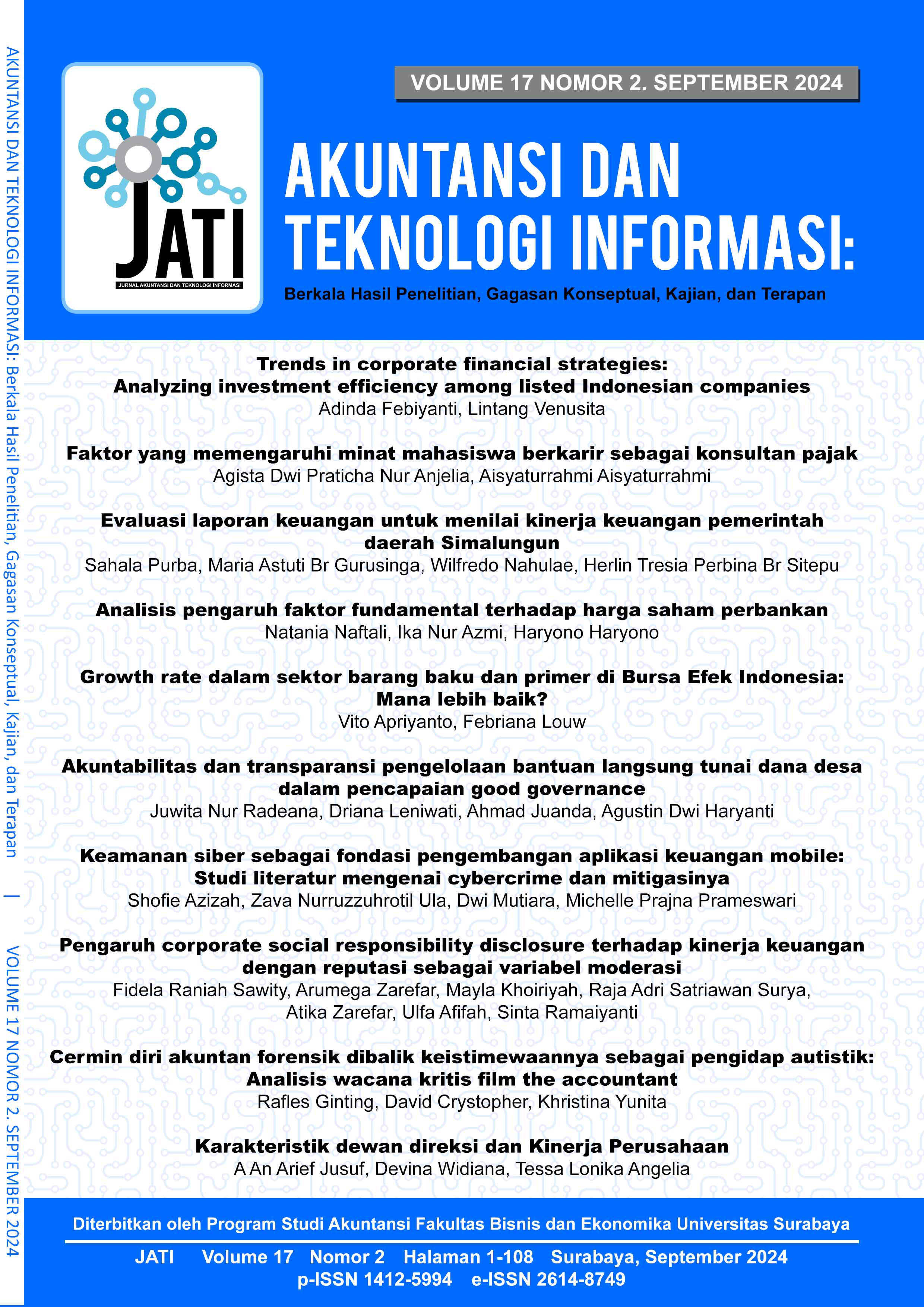Keamanan siber sebagai fondasi pengembangan aplikasi keuangan mobile: Studi literatur mengenai cybercrime dan mitigasinya
 Abstract Views:
2326 times
Abstract Views:
2326 times
 PDF Downloads:
2158 times
PDF Downloads:
2158 times
Abstract
This study examines the importance of cybersecurity in mobile financial applications, particularly in the face of rising cybercrime threats. The aim of this research is to provide deeper insights into the significance of cybersecurity in mobile financial apps and to develop approaches that financial companies can adopt to protect their users' data and information. The research employs a qualitative descriptive method using a systematic literature review (SLR) approach. Meta-synthesis analysis is applied to synthesize data from 26 journal articles published between 2019 and 2024. The findings reveal that cybercrime in the financial and FinTech industries is driven by internal factors such as weak security systems, lack of system updates, limited human resource competencies, and careless user behavior. External factors include malware attacks, unclear regulations, and the use of advanced technology. To counter these, it is necessary to implement technologies such as firewalls and blockchain, strong risk management, enhanced network infrastructure, the establishment of cybersecurity teams, the development of clear regulations, and user education to raise awareness and improve cybersecurity. Therefore, the implementation of a comprehensive cybersecurity strategy is crucial in maintaining the integrity and trust of users in mobile financial applications.
Downloads
References
Abdulrahaman, M. D., Alhassan, J. K., Ojeniyi, J. A., & Abdulhamid, S. M. (2019). Security Risk Analysis and Management in mobile wallet transaction: A Case study of Pagatech Nigeria Limited. International Journal of Computer Network and Information Security, 10(12), 21–33. https://doi.org/10.5815/ijcnis.2018.12.03
Al-Harrasi, A., Shaikh, A. K., & Al-Badi, A. (2021). Towards protecting organisations’ data by preventing data theft by malicious insiders. International Journal of Organizational Analysis, 31(3), 875–888.
Ardiyanti, H. (2019). Cyber-Security Dan Tantangan Pengembangannya Di Indonesia. Jurnal Politica, 5(1), 95–110.
Assifa, B. A. (2023). Perlindungan Hukum Terhadap Nasabah Bank Syariah Indonesia dari serangan Cybercrime. Universitas Islam Negeri Syarif Hidayatullah Jakarta.
Demirkan, S., Demirkan, I., & McKee, A. (2020). Blockchain technology in the future of business cyber security and accounting. Journal of Management Analytics, 7(2), 189–208. https://doi.org/10.1080/23270012.2020.1731721
Fitria, K. M. (2023). Analisis Serangan Malware Dalam Perbankan Dan Perencanaan Solusi Keamanan. Jurnal Informatika Dan Teknik Elektro Terapan, 11(3). https://doi.org/10.23960/jitet.v11i3.3312
Hartono, B. (2023). Ransomware: Memahami Ancaman Keamanan Digital. Bincang Sains Dan Teknologi, 2(02), 55–62. https://doi.org/10.56741/bst.v2i02.353
Ilhamdi, Y., & Kunang, Y. N. (2021). Analisis Malware Pada Sistem Operasi Windows Menggunakan Teknik Forensik. Bina Darma Conference on Computer Science, 3, 256–264.
Islam, M. S. (2019). Systematic Literature Review: Security Challenges of Mobile Banking and Payments System. International Journal of U- and e-Service, Science and Technology, 7(6), 107–116. https://doi.org/10.14257/ijunesst.2014.7.6.10
Javaid, M., Haleem, A., Singh, R. P., Suman, R., & Khan, S. (2022). A review of Blockchain Technology applications for financial services. BenchCouncil Transactions on Benchmarks, Standards and Evaluations, 2(3), 100073. https://doi.org/10.1016/j.tbench.2022.100073
Kitchenham, B., & Brereton, P. (2013). A systematic review of systematic review process research in software engineering. In Information and Software Technology (Vol. 55, Issue 12). https://doi.org/10.1016/j.infsof.2013.07.010
Kumari, R., Jasojit, T., Kumari, R., Jasojit, T., Keuangan, K., & Penulis, U. (2017). Jurnal Regulasi dan Kepatuhan Keuangan.
Kunnas, J. (2022). EMPLOYEE ATTITUDES TOWARDS INFORMATION Identifying archetypes using machine learning Bachelor ’ s Thesis Juho Kunnas Aalto University School of Business Information and Service Management. Aalto University School of Business Information and Service Management.
Kurniawan, F. A., & Solihin, K. (2022). Penguatan Manajemen Risiko Lembaga Keuangan Syariah Non-Bank dalam Menghadapi Ancaman Cyber Security. JIOSE: Journal of Indonesian Sharia Economics, 1(1), 1–20. https://doi.org/10.35878/jiose.v1i1.360
Laidlaw. (2021). Privacy and Cybersecurity in Digital Trade: The Challenge of Cross Border Data Flows. SSRN Electronic, 10(1), 1–81.
Maulana, B. R., & Nasrulloh, N. (2024). Analisis Strategi Pemulihan Citra Bank Syariah Indonesia Pasca Dugaan Serangan Siber. Ekonomi Syariah Dan Bisnis Perbankan, 8(1), 76–91.
Meidiandra, M. K., Sari, Y. P., & Sutabri, T. (2023). Mendesain Cyber Security Core Banking System untuk Keamanan Menggunakan Firewall Pada PT. Bank Syariah Indonesia Tbk. Syntax Idea, 5(7), 843–848.
Mohamed, A. O. Y. (2023). Intelligent Blockchain-Based Secure Framework for Transaction in Mobile Electronic Payment System. International Journal of Interactive Mobile Technologies, 17(4), 37–46. https://doi.org/10.3991/ijim.v17i04.37671
Ng, A., & Kwok, B. K. B. (2019). Emergence of Fintech and cybersecurity in a global financial centre. Journal of Financial Regulation and Compliance, 25(4), 422–434. https://doi.org/10.1108/jfrc-01-2017-0013
Ouytsel, J. Van. (2021). The prevalence and motivations for password sharing practices and intrusive behaviors among early adolescents’ best friendships – A mixed-methods study. Telematics and Informatics, 63(101668).
Raodia, R. (2019). Pengaruh Perkembangan Teknologi Terhadap Terjadinya Kejahatan Mayantara (Cybercrime). Jurisprudentie : Jurusan Ilmu Hukum Fakultas Syariah Dan Hukum, 6(2), 39. https://doi.org/10.24252/jurisprudentie.v6i2.11399
Rawindaran, N., Jayal, A., Prakash, E., & Hewage, C. (2023). Perspective of small and medium enterprise (SME’s) and their relationship with government in overcoming cybersecurity challenges and barriers in Wales. International Journal of Information Management Data Insights, 3(2), 100191. https://doi.org/10.1016/j.jjimei.2023.100191
Restika, R., & Sonita, E. (2023). Tantangan Keamanan Siber Dalam Manajemen Likuiditas Bank Syariah : Menjaga Stabilitas Keuangan Di Era Digital. Krigan: Journal of Management and Sharia Business, 1(2), 25. https://doi.org/10.30983/krigan.v1i2.7929
Riskiyadi, M., Anggono, A., & Tarjo. (2021). Cybercrime dan Cybersecurity pada Fintech: Sebuah Tinjauan Pustaka Sistematis. Jurnal Manajemen Dan Organisasi, 12(3), 239–251. https://doi.org/10.29244/jmo.v12i3.33528
Septasari, D. (2023). The Cyber Security and The Challenge of Society 5.0 Era in Indonesia. Aisyah Journal Of Informatics and Electrical Engineering (A.J.I.E.E), 5(2), 227–233. https://doi.org/10.30604/jti.v5i2.231
Suhaemin, A., & Muslih. (2023). Karakteristik Cybercrime di Indonesia. EduLaw : Journal of Islamic Law and Yurisprudance, 5(2), 15–26.
Sumadi, M. I. T. B. N., Putra, R., & Firmansyah, A. (2022). Peran Perkembangan Teknologi Pada Profesi Akuntan Dalam Menghadapi Industri 4.0 Dan Society 5.0. Journal of Law, Administration, and Social Science, 2(1), 56–68. https://doi.org/10.54957/jolas.v2i1.162
Suwarno, R., Cahyono, D., & Maharani, A. (2022). Systematic Literature Review: Faktor Keunggulan Bank Syariah Di Indonesia. Jurnal Peneliti Ekonomi, 1(6), 40–54.
Una, B. K., & Prabowo, H. Y. (2022). Fintech lending fraud prevention strategy: A case study. Journal of Contemporary Accounting, 4(1), 37–52.
Wang, S., Asif, M., Shahzad, M. F., & Ashfaq, M. (2024). Data privacy and cybersecurity challenges in the digital transformation of the banking sector. Journal Computers & Security, 147(104051).
Wang, Y. (2023). Application of Big Data Technology in Mobile Payment Security. Journal of Research in Social Science and Humanities, 2(12), 18–23. https://doi.org/10.56397/jrssh.2023.12.04
Widiyati, D., & Erliana. (2024). Pengaruh Literasi Keuangan, Perlindungan Data, dan Cybersecurity terhadap Penggunaan Financial Technology. JURNAL AKUNTANSI DAN EKONOMI AKREDITASI NOMOR, 9(1), 130–141. https://doi.org/10.29407/jae.v9i1.21945
Yang, T. (2020). Mobile Payment Security in the Context of Big Data: Certificateless Public Key Cryptography. International Journal of Network Security, 22(4), 621–626.
Yohanes, N., & Perajaka, M. A. (2021). Penerapan Model Manajemen Risiko Teknologi Digital di Lembaga Perbankan Berkaca pada Cetak Biru Transformasi Digital Perbankan Indonesia. Jurnal Manajemen Risiko, 2(2), 59–74.

This work is licensed under a Creative Commons Attribution-ShareAlike 4.0 International License.
- Copyright on articles is retained by the respective author(s), without restrictions. A non-exclusive license is granted to Akuntansi dan Teknologi Informasi (JATI) to publish the article and identify itself as its original publisher, along with the commercial right to include the article in a hardcopy issue for sale to libraries and individuals.
- Articles published in Akuntansi dan Teknologi Informasi (JATI) are licensed under a Creative Commons Attribution-ShareAlike 4.0 International license. You are free to copy, transform, or redistribute articles for any lawful purpose in any medium, provided you give appropriate credit to the original author(s) and the journal, link to the license, indicate if changes were made, and redistribute any derivative work under the same license.
- By publishing in Akuntansi dan Teknologi Informasi (JATI), authors grant any third party the right to use their article to the extent provided by the Creative Commons Attribution-ShareAlike 4.0 International license.

 DOI:
DOI:









